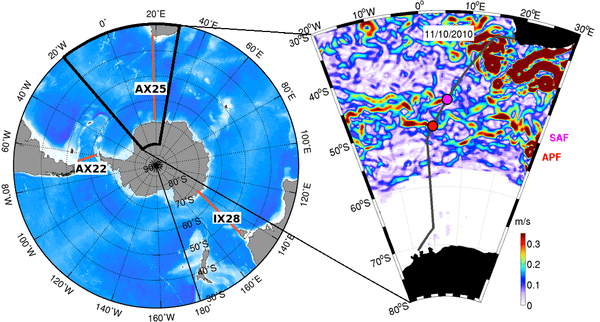by Ricardo Domingues, Gustavo Goni, Sebastiaan Swart, and Shenfu Dong
Researchers from PhOD and from the University of Cape Town used temperature data from the AX25 repeat XBT transect (from South Africa to Antarctica) in combination with other hydrographic and satellite observations to report a mechanism by which local winds alter the structure of the Antarctic Circumpolar Current flow south of Africa.
Changes in the local Antarctic Circumpolar Current (ACC) structure were found to be due to anomalies of opposite signs in the transports of the Subantarctic Front (SAF) and of the Antarctic Polar Front (APF) caused by latitudinal shifts of the westerlies (Figure 2). For example, during positive phases of the Southern Annular Mode, the southward displaced westerlies drive an intensification of the APF transport and a weakening of the SAF transport. These results demonstrate that the structure the ACC transport can be longitudinally modulated by local winds, even though the net transport of this current is set by integrated winds over the Southern Ocean. This mechanism may have potential implications for the Atlantic-Indian heat and mass exchanges, because the SAF and APF carry water masses with different properties. The manuscript entitled “Wind forced variability of the Antarctic Circumpolar Current south of Africa between 1993-2010” has been published on the Journal of Geophysical Research – Oceans.


Domingues, R., G. J. Goni, S. Swart, and D. Dong, 2014. Atmospherically forced variability of the Antarctic Circumpolar Current south of Africa between 1993 – 2010, J. Geophys. Res. Doi: 10.1016/j.csr.2013.12.009. [PDF]